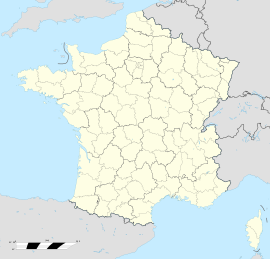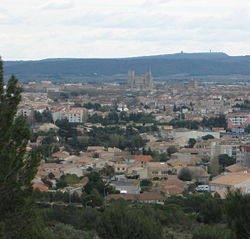- Narbonne
-
"Narbo" redirects here. For the former town in California, see Narbo, California.
Narbonne
Narbona


Administration Country France Region Languedoc-Roussillon Department Aude Arrondissement Narbonne Intercommunality Narbonne Mayor Jacques Bascou (PS)
(2008–2014)Statistics Elevation 0–285 m (0–935 ft) Land area1 172.96 km2 (66.78 sq mi) Population2 52,252 (2008) - Density 302 /km2 (780 /sq mi) INSEE/Postal code 11262/ 11100 1 French Land Register data, which excludes lakes, ponds, glaciers > 1 km² (0.386 sq mi or 247 acres) and river estuaries. 2 Population without double counting: residents of multiple communes (e.g., students and military personnel) only counted once. Coordinates: 43°11′01″N 3°00′15″E / 43.1836°N 3.0042°E
Narbonne (French pronunciation: [naʁ.bɔn]; Occitan: Narbona; Latin: Narbo) is a commune in southern France in the Languedoc-Roussillon region. It lies 849 km (528 mi) from Paris in the Aude department, of which it is a sub-prefecture. Once a prosperous port, it is now located about 15 km (9.3 mi) from the shores of the Mediterranean Sea. It is marginally the largest commune in Aude, although the capital is the slightly smaller commune of Carcassonne.
Contents
Geography
Narbonne is linked to the nearby Canal du Midi and the Aude River by the Canal de la Robine, which runs through the centre of town.
Etymology
The name is coming from the Iberian/Bbasque root *narb- "water, river, marsh"[1]
History
Narbonne was established in Gaul in 118 BC, as Colonia Narbo Martius. It was located on the Via Domitia, the first Roman road in Gaul, built at the time of the foundation of the colony, and connecting Italy to Spain. Geographically, Narbonne was therefore located at a very important crossroads because it was situated where the Via Domitia connected to the Via Aquitania, which led toward the Atlantic through Toulouse and Bordeaux. In addition, it was crossed by the Aude River. Surviving members of Julius Caesar's Legio X Equestris were given lands in the area that today is called Narbonne.[citation needed]
Politically, Narbonne gained importance as a competitor to Massalia (Marseille). Julius Caesar settled veterans from his 10th legion there and attempted to develop its port while Marseille was revolting against Roman control. Among the amenities of Narbonne, its rosemary-flower honey was famous among Romans.[2]
Later, the provincia of southern Gaul was named "Gallia Narbonensis", after the city, and Narbonne was made its capital. Seat of a powerful administration, the city enjoyed economic and architectural expansion.
It was subsequently the capital of the Visigothic province of Septimania. For 40 years, from 719, Narbonne was part of the Emirate of Cordoba until conquered by the Franks in 759, after which it became part of the Carolingian Viscounty of Narbonne. In the 12th century, the court of Ermengarde of Narbonne (reigned 1134 to 1192) presided over one of the cultural centers where the spirit of courtly love was developed.
In the 11th and 12th centuries, Narbonne was home to an important Jewish exegetical school, which played a pivotal role in the growth and development of the Zarphatic (Judæo-French) and Shuadit (Judæo-Provençal) languages. Jews had settled in Narbonne from about the 5th century, with a community that had risen to approximately 2000 in the 12th century. At this time, Narbonne was frequently mentioned in Talmudic works in connection with its scholars. One source, Abraham ibn Daud of Toledo, gives them an importance similar to the exilarchs of Babylon.[3] In the 12th and 13th centuries, the community went through a series of ups and downs before settling into extended decline.
Narbonne loses its river and port
Narbonne itself fell into a slow decline in the 14th century, for a variety of reasons. One was due to a change in the course of the Aude River, which caused increased silting of the navigational access. The river, known as the Atax in ancient times, had always had two main courses which split close to Salelles; one fork going south through Narbonne and then to the sea close to the Clappe Massif, the other heading east to the etang at Vendres close to the current mouth of the river well to the east of the city. The Romans had improved the navigability of the river by building a dam near Salelles and also by canalising the river as it passed through its marshy delta to the sea (then as now the canal was known as the Robine.) A major flood in 1320 swept the dam away. The Aude river had a long history of overflowing its banks. When it was a bustling port, the distance from the coast was approximately 5 to 10 kilometres, but at that time the access to the sea was deep enough when the river was in full spate which made communication between port and city unreliable. However, goods could easily be transported by land and in shallow barges from the ports (there were several: a main port and forward ports for larger vessels; indeed the navigability from the sea into the etang and then into the river had been a perennial problem!)
The changes to the long seashore which resulted from the silting up of the series of graus or openings which were interspersed between the islands which made up the shoreline (St. Martin; St. Lucie) had a more serious impact than the change in course of the river. Other causes of decline were the plague and the raid of Edward, the Black Prince, which caused much devastation. The growth of other ports was also a factor.
Narbonne Cathedral
Narbonne Cathedral, dedicated to Saints Justus and Pastor, provides stark evidence of Narbonne's sudden and dramatic change of fortunes when one sees at the rear of the structure the enormously ambitious building programme frozen in time, for the cathedral—still one of the tallest in France—was never finished. The reasons are many, but the most important is that the completed cathedral would have required demolishing the city wall. The 14th century also brought the plague and a host of reasons for retaining the 5th-century (pre-Visigothic) walls.
Yet the choir, side chapels, sacristry, and courtyard remain intact, and the cathedral, although no longer the seat of a bishop or archbishop, remains the primary place of worship for the Roman Catholic population of the city, and is a major tourist attraction.
Building of the Canal de la Robine
From the sixteenth century, eager to maintain a link to important trade, the people of Narbonne began costly work to the vestiges of the Aude River's access to the sea so that it would remain navigable to a limited draft vessel and also serve as a link with the Royal Canal. This major undertaking resulted in the construction of the Canal de la Robine, which was finally linked with the Canal du Midi (then known as the Royal Canal) via the Canal de Jonction in 1776. In the 19th century, the canal system in the south of France came into competition with an expanding rail network, but kept some importance due to the flourishing wine trade.
Hence, despite its decline from Roman times, Narbonne managed to hold on to its vital but limited importance as a trading route, particularly in more recent centuries.
Population
Historical population of Narbonne 1793 1800 1806 1821 1831 1836 1841 1846 1851 9050 9086 9464 9940 10,246 10,762 11,907 11,427 13,066 1856 1861 1866 1872 1876 1881 1886 1891 14,300 16,062 17,172 17,266 19,968 28,134 29,702 29,566 1896 1901 1906 1911 1921 1926 1931 1936 27,824 28,852 27,039 28,173 28,956 29,841 31,909 30,047 1946 1954 1962 1968 1975 1982 1990 1999 29,975 32,060 33,891 38,441 39,342 41,565 45,849 46,510 2008 52,252 Main sights
- The cathedral dating from 1272
- The Palais des Archevêques, the Archbishop's Palace, and its donjon with views over Narbonne
- Musée Archeologique, an archaeological museum in the town centre
- The Roman Horreum, a former grain warehouse, built underground as a cryptoporticus
- Remains of the Via Domitia in the city center
- The canal, Canal de la Robine, running through the centre of the town
- The Halles covered market operates every day. The busiest times are Sunday and Thursday mornings.
- The nearby limestone massif known as La Clape and the beach at Narbonne plage
Sport
Narbonne is home to the rugby union team RC Narbonne. Racing Club de Narbonne Méditerannée (also known as RC Narbonne) is a French rugby union club that played the 2007-08 season in the second-level Rugby Pro D2, after finishing at the bottom of the 2006-07 Top 14 table. They were founded in 1907. They play at the Parc des Sports Et de l'Amitié (capacity 12,000). They wear orange and black.
Transport
The Gare de Narbonne railway station offers direct connections to Paris, Barcelona, Toulouse, Marseille and several regional destinations.
Personalities
- Léon Blum was born in Paris but was elected as Deputy for Narbonne in 1929, re-elected in 1932 and 1936.
- Makhir of Narbonne, medieval Jewish scholar
- Saint Sébastien, third-century Christian saint and martyr
- Dimitri Szarzewski, rugby player
- Charles Trenet, singer and songwriter
See also
- Bierzo Edict
- Corbières AOC
- Communes of the Aude department
References
- ^ Michel Morvan Dictionnaire étymologique basque
- ^ Maguelonne Toussaint-Samat (Anthea Bell, tr.) The History of Food, 2nd ed. 2009:23.
- ^ Jewish encyclopedia.
- Michel Gayraud, Narbonne antique des origines à la fin du IIIe siècle. Paris: De Boccard, Revue archéologique de Narbonnaise, Supplément 8, 1981, 591 p.
- Histoire de Narbonne, Jacques Michaud and André Cabanis, eds, Toulouse: Privat, 2004.
- L’Aude de la préhistoire à nos jours (under the direction of Jacques Crémadeilis), Saint-Jean-d’Angély, 1989.
- Les Audois : dictionnaire biographique, Rémy Cazals et Daniel Fabre, eds., Carcassonne, Association des Amis des Archives de l’Aude, Société d’Études Scientifiques de l’Aude, 1990.
External links
- Official website (French)
Categories:- Aude
- Communes of Aude
- Narbonne
- Subprefectures in France
- 118 BC establishments
- Populated places established in the 2nd century BC
Wikimedia Foundation. 2010.





